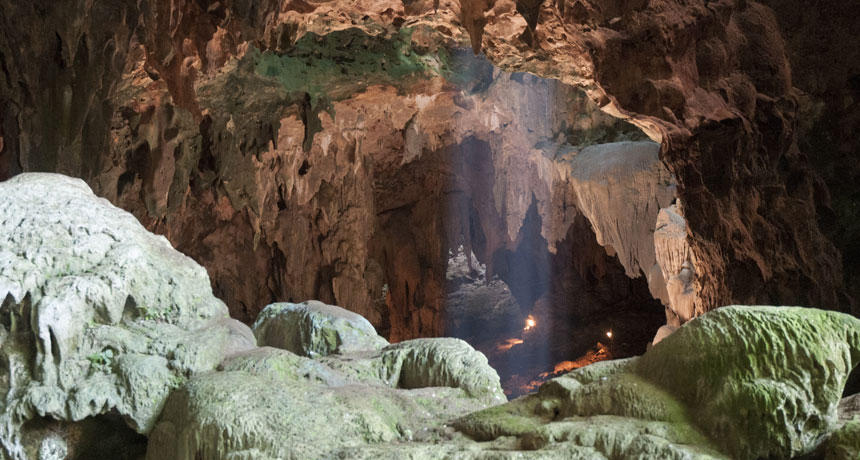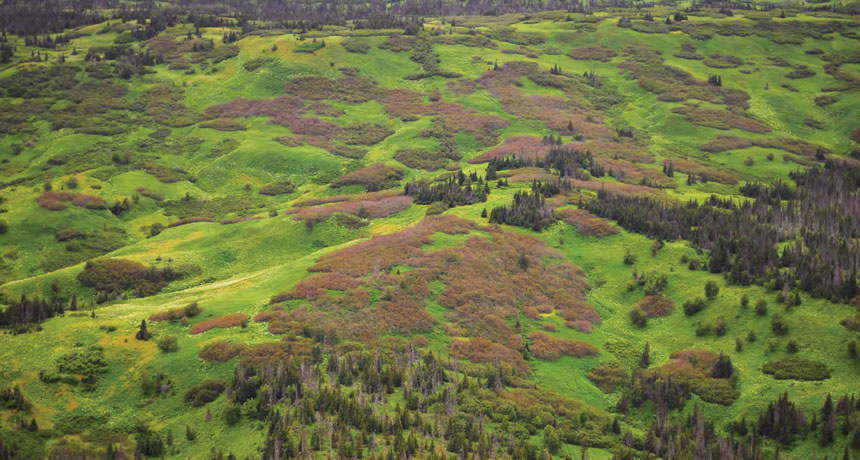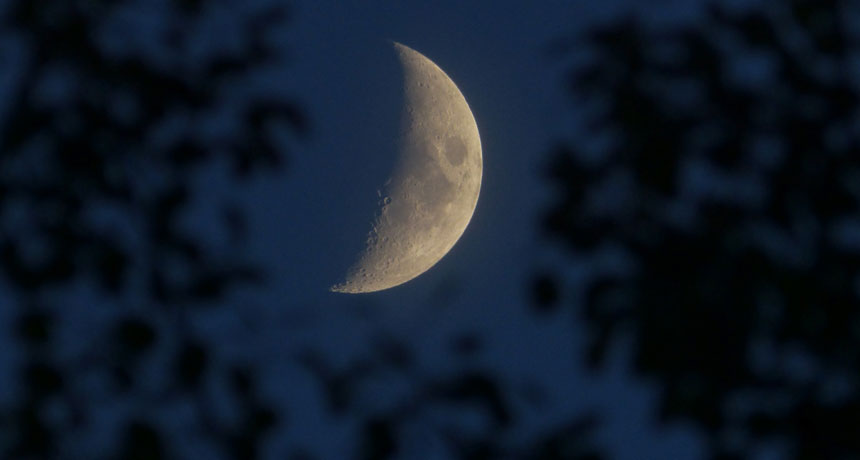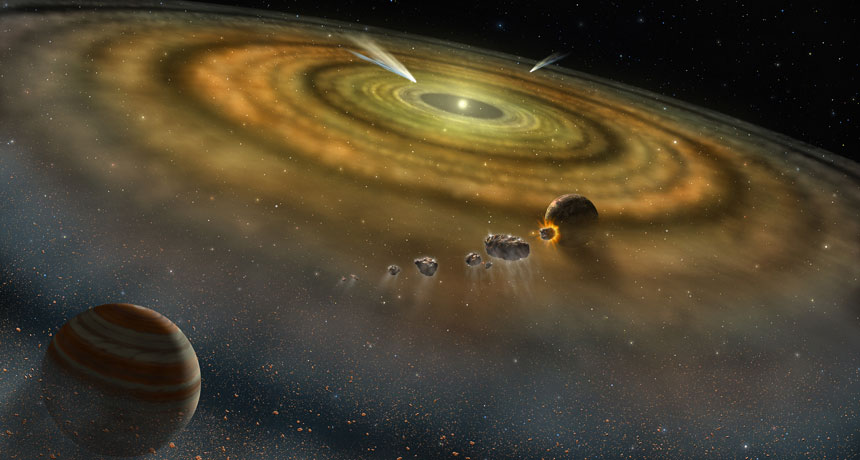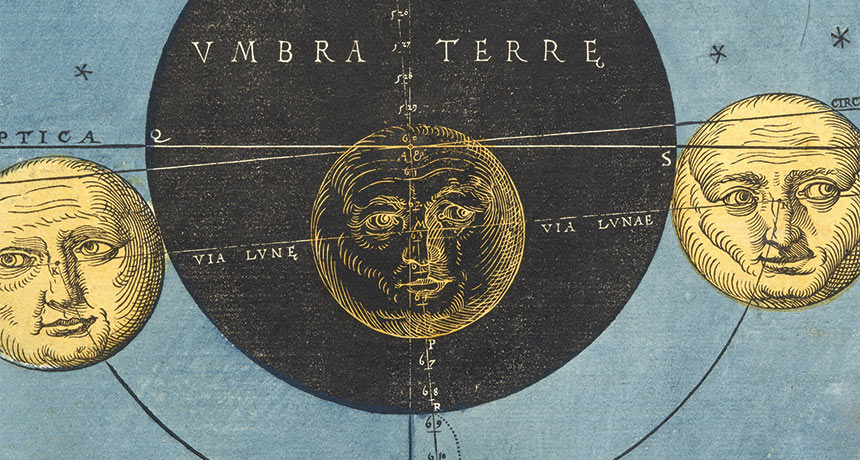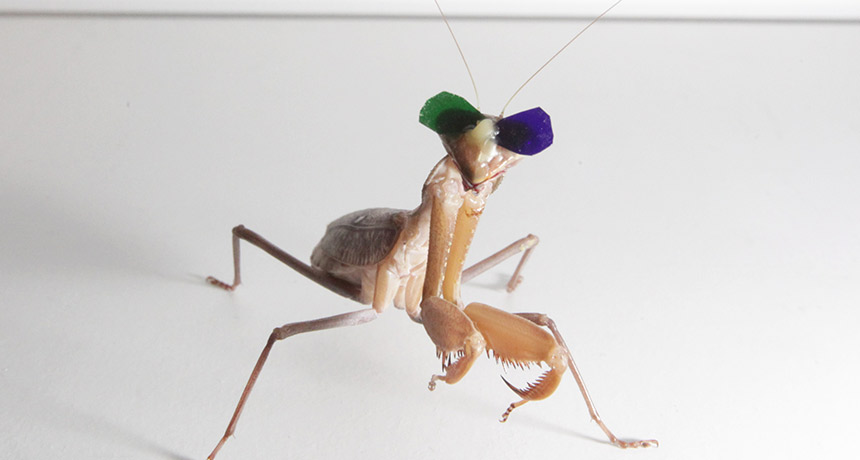How scientists took the first picture of a black hole

Black holes are extremely camera shy. Supermassive black holes, ensconced in the centers of galaxies, make themselves visible by spewing bright jets of charged particles or by flinging away or ripping up nearby stars. Up close, these behemoths are surrounded by glowing accretion disks of infalling material. But because a black hole’s extreme gravity prevents light from escaping, the dark hearts of these cosmic heavy hitters remain entirely invisible.
Luckily, there’s a way to “see” a black hole without peering into the abyss itself. Telescopes can look instead for the silhouette of a black hole’s event horizon — the perimeter inside which nothing can be seen or escape — against its accretion disk. That’s what the Event Horizon Telescope, or EHT, did in April 2017, collecting data that has now yielded the first image of a supermassive black hole, the one inside the galaxy M87.
“There is nothing better than having an image,” says Harvard University astrophysicist Avi Loeb. Though scientists have collected plenty of indirect evidence for black holes over the last half century, “seeing is believing.”
Creating that first-ever portrait of a black hole was tricky, though. Black holes take up a minuscule sliver of sky and, from Earth, appear very faint. The project of imaging M87’s black hole required observatories across the globe working in tandem as one virtual Earth-sized radio dish with sharper vision than any single observatory could achieve on its own.
Putting the ‘solution’ in resolution
Weighing in around 6.5 billion times the mass of our sun, the supermassive black hole inside M87 is no small fry. But viewed from 55 million light-years away on Earth, the black hole is only about 42 microarcseconds across on the sky. That’s smaller than an orange on the moon would appear to someone on Earth. Still, besides the black hole at the center of our own galaxy, Sagittarius A* or Sgr A* — the EHT’s other imaging target — M87’s black hole is the largest black hole silhouette on the sky.
Only a telescope with unprecedented resolution could pick out something so tiny. (For comparison, the Hubble Space Telescope can distinguish objects only about as small as 50,000 microarcseconds.) A telescope’s resolution depends on its diameter: The bigger the dish, the clearer the view — and getting a crisp image of a supermassive black hole would require a planet-sized radio dish.
Even for radio astronomers, who are no strangers to building big dishes (SN Online: 9/29/17), “this seems a little too ambitious,” says Loeb, who was not involved in the black hole imaging project. “The trick is that you don’t cover the entire Earth with an observatory.”
Instead, a technique called very long baseline interferometry combines radio waves seen by many telescopes at once, so that the telescopes effectively work together like one giant dish. The diameter of that virtual dish is equal to the length of the longest distance, or baseline, between two telescopes in the network. For the EHT in 2017, that was the distance from the South Pole to Spain.
Telescopes, assemble!
The EHT was not always the hotshot array that it is today, though. In 2009, a network of just four observatories — in Arizona, California and Hawaii — got the first good look at the base of one of the plasma jets spewing from the center of M87’s black hole (SN: 11/3/12, p. 10). But the small telescope cohort didn’t yet have the magnifying power to reveal the black hole itself.
Over time, the EHT recruited new radio observatories. By 2017, there were eight observing stations in North America, Hawaii, Europe, South America and the South Pole. Among the newcomers was the Atacama Large Millimeter/submillimeter Array, or ALMA, located on a high plateau in northern Chile. With a combined dish area larger than an American football field, ALMA collects far more radio waves than other observatories.
“ALMA changed everything,” says Vincent Fish, an astronomer at MIT’s Haystack Observatory in Westford, Mass. “Anything that you were just barely struggling to detect before, you get really solid detections now.”
More than the sum of their parts
EHT observing campaigns are best run within about 10 days in late March or early April, when the weather at every observatory promises to be the most cooperative. Researchers’ biggest enemy is water in the atmosphere, like rain or snow, which can muddle with the millimeter-wavelength radio waves that the EHT’s telescopes are tuned to.
But planning for weather on several continents can be a logistical headache.
“Every morning, there’s a frenetic set of phone calls and analyses of weather data and telescope readiness, and then we make a go/no-go decision for the night’s observing,” says astronomer Geoffrey Bower of the Academia Sinica Institute of Astronomy and Astrophysics in Hilo, Hawaii. Early in the campaign, researches are picky about conditions. But toward the tail end of the run, they’ll take what they can get.
When the skies are clear enough to observe, researchers steer the telescopes at each EHT observatory toward the vicinity of a supermassive black hole and begin collecting radio waves. Since M87’s black hole and Sgr A* appear on the sky one at a time — each one about to rise just as the other sets — the EHT can switch back and forth between observing its two targets over the course of a single multi-day campaign. All eight observatories can track Sgr A*, but M87 is in the northern sky and beyond the South Pole station’s sight.
On their own, the data from each observing station look like nonsense. But taken together using the very long baseline interferometry technique, these data can reveal a black hole’s appearance.
Here’s how it works. Picture a pair of radio dishes aimed at a single target, in this case the ring-shaped silhouette of a black hole. The radio waves emanating from each bit of that ring must travel slightly different paths to reach each telescope. These radio waves can interfere with each other, sometimes reinforcing one another and sometimes canceling each other out. The interference pattern seen by each telescope depends on how the radio waves from different parts of the ring are interacting when they reach that telescope’s location.
For simple targets, such as individual stars, the radio wave patterns picked up by a single pair of telescopes provide enough information for researchers to work backward and figure out what distribution of light must have produced those data. But for a source with complex structure, like a black hole, there are too many possible solutions for what the image could be. Researchers need more data to work out how a black hole’s radio waves are interacting with each other, offering more clues about what the black hole looks like.
The ideal array has as many baselines of different lengths and orientations as possible. Telescope pairs that are farther apart can see finer details, because there’s a bigger difference between the pathways that radio waves take from the black hole to each telescope. The EHT includes telescope pairs with both north-south and east-west orientations, which change relative to the black hole as Earth rotates.
Pulling it all together
In order to braid together the observations from each observatory, researchers need to record times for their data with exquisite precision. For that, they use hydrogen maser atomic clocks, which lose about one second every 100 million years.
There are a lot of data to time stamp. “In our last experiment, we recorded data at a rate of 64 gigabits per second, which is about 1,000 times [faster than] your home internet connection,” Bower says.
These data are then transferred to MIT Haystack Observatory and the Max Planck Institute for Radio Astronomy in Bonn, Germany, for processing in a special kind of supercomputer called a correlator. But each telescope station amasses hundreds of terabytes of information during a single observing campaign — far too much to send over the internet. So the researchers use the next best option: snail mail. So far, there have been no major shipping mishaps, but Bower admits that mailing the disks is always a little nerve-wracking.
Though most of the EHT data reached Haystack and Max Planck within weeks of the 2017 observing campaign, there were no flights from South Pole until November. “We didn’t get the data back from the South Pole until mid-December,” says Fish, the MIT Haystack astronomer.
Filling in the blanks
Combining the EHT data still isn’t enough to render a vivid picture of a supermassive black hole. If M87’s black hole were a song, then imaging it using only the combined EHT data would be like listening to the piece played on a piano with a bunch of broken keys. The more working keys — or telescope baseline pairs — the easier it is to get the gist of the melody. “Even if you have some broken keys, if you’re playing all the rest of them correctly, you can figure out the tune, and that’s partly because we know what music sounds like,” Fish says. “The reason we can reconstruct images, even though we don’t have 100 percent of the information, is because we know what images look like” in general.
There are mathematical rules about how much randomness any given picture can contain, how bright it should be and how likely it is that neighboring pixels will look similar. Those basic guidelines can inform how software decides which potential images, or data interpretations, make the most sense.
Before the 2017 observing campaign, the EHT researchers held a series of imaging challenges to make sure their computer algorithms weren’t biased toward creating images to match expectations of what black holes should look like. One person would use a secret image to generate faux data of what telescopes would see if they were peering at that source. Then other researchers would try to reconstruct the original image.
“Sometimes the true image was not actually a black hole image,” Fish says, “so if your algorithm was trying to find a black hole shadow … you wouldn’t do well.” The practice runs helped the researchers refine the data processing techniques used to render the M87 image.
Black holes and beyond
So, the black hole inside M87 finally got its closeup. Now what?
The EHT’s black hole observations are expected to help answer questions like how some supermassive black holes, including M87’s, launch such bright plasma jets (SN Online: 3/29/19). Understanding how gas falls into and feeds black holes could also help solve the mystery of how some black holes grew so quickly in the early universe, Loeb says (SN Online: 3/16/18).
The EHT could also be used, Loeb suggests, to find pairs of supermassive black holes orbiting one another — similar to the two stellar mass black holes whose collision created gravitational waves detected in 2015 by the Advanced Laser Interferometer Gravitational-Wave Observatory, or Advanced LIGO (SN: 3/5/16, p. 6). Getting a census of these binaries may help researchers identify targets for the Laser Interferometer Space Antenna, or LISA, which will search from space for gravitational waves kicked up by the movement of objects like black holes (SN Online: 6/20/17).
The EHT doesn’t have many viable targets other than supermassive black holes, says astrophysicist Daniel Marrone, at the University of Arizona in Tucson. There are few other things in the universe that appear as tiny but luminous as the space surrounding a supermassive black hole. “You have to be able to get enough light out of the really tiny patches of sky that we can detect,” Marrone says. “In principle, we could be reading alien license plates or something,” but they’d need to be super bright.
Too bad for alien seekers. Still, even if the EHT is a one-trick pony, spying supermassive black holes is a pretty neat trick.
